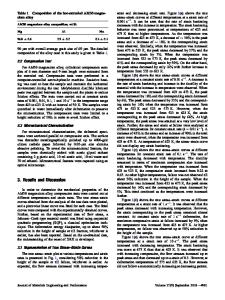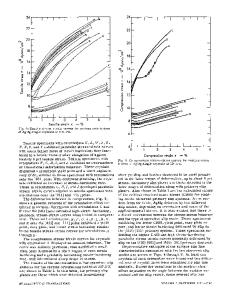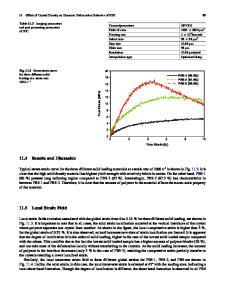Deformation behavior of silicon
- PDF / 1,985,187 Bytes
- 15 Pages / 612 x 792 pts (letter) Page_size
- 55 Downloads / 304 Views
I. INTRODUCTION
SILICON is completely brittle at low temperatures and becomes ductile gradually as the temperature is raised. A rough measure for the brittle-to-ductile transition temperature may be taken to be about 500 8C. The transition temperature depends on the deformation rate of a specimen to some extent. It shifts to a high temperature when the specimen is stressed at a slow rate and shifts to a low temperature when the specimen in stressed at a high rate. All such features reflect the dynamic property of dislocations in Si. As in other kinds of diamond-type crystals, plastic deformation of Si at high temperature takes place by means of slip along the {111} planes in the ^110& directions. Such plastic deformation of Si by slip is brought about by glide motion of dislocations having the Burgers vectors of the (a/2)^110&type along the {111}planes, where a is the lattice parameter. A high density of dislocations undergo glide motion at some appreciable velocity when a crystal is deformed plastically on a macroscopic scale. Deformation behavior of any crystal observed macroscopically is determined by a number of microscopic processes related to dislocations, such as generation, multiplication, motion, interaction with each other, and interaction with impurities. The basic equation that relates macroscopic deformation of a crystal with the dynamic state of dislocations inside it is given by «˙ 5 N v b [1] pl
where «˙ pl is the plastic shear strain rate of the crystal, N the density, v the mean velocity, and b the magnitude of the Burgers vector of dislocations in motion. In Eq. [1], the deformation of the crystal is assumed to take place by means of slip of a single slip system. The dislocation density is defined to be the length of dislocations contained in a unit volume of the crystal and has the dimension of cm22. This article discusses the mechanical properties of Si observed at high temperature in terms of microscopic processes of dislocations. First, some basic properties and KOJI SUMINO, Executive Advisor, Nippon Steel Corporation, Chiba Prefecture 293-8511, Japan, is Professor Emeritus, Tohoku University, Sendai 980-8577, Japan. METALLURGICAL AND MATERIALS TRANSACTIONS A
dynamic behavior of dislocations in Si are reviewed. Mechanical characteristics of Si at high temperatures are then stated. Finally, it is shown how observed mechanical behavior of Si is described quantitavely on the bases of various dislocation processes. Effects of impurities, especially those of oxygen impurities, on both dynamic behavior of dislocations and mechanical properties of Si crystals are also shown in some detail. Oxygen impurities are the main impurities in Si crystals grown by the Czochralski technique, which are widely used in microelectronics.
II. GEOMETRICAL FEATURE OF DISLOCATIONS IN SILICON A dislocation in a Si crystal is energetically favorable when it lies along the most closely packed direction, which is one of the ^110& directions. Thus, a stable dislocation in Si lying on the (111) plane is either a 60 deg
Data Loading...







